Discover Istanbul's Most Stunning Churches: A Historical Tour Guide
Istanbul has been the crossroads of different civilisations and faiths for centuries and is considered one of the most fascinating cities in the world with its unique historical texture. The churches built in this ancient city, from the Byzantine Empire to the Ottoman Empire to the present day, are not only religious sanctuaries, but also living witnesses of architectural, artistic and cultural heritage. These outstanding churches to visit in Istanbul offer guests both a profound spiritual experience and an unforgettable journey into the layered history of the city. So, where are the best churches in Istanbul? How to visit the churches in Istanbul? Let's explore together. 👇
1. Hagia Sophia-i Kebir Mosque (Hagia Sophia)

Hagia Sophia, one of the first buildings that comes to mind when it comes to Istanbul, is one of the masterpieces of world architectural history. Built as a cathedral by the Byzantine Emperor Justinian I between 532-537, this enormous structure was the largest place of worship in the Christian world for nearly a thousand years. In 1453, after the conquest of Istanbul, it was converted into a mosque; in 1935, it was converted into a museum, and in 2020, it regained the status of a mosque. As of 2024, the upper gallery of the building serves as a ticketed museum section for foreign visitors, while the prayer area is open to Muslims for worship.
Architectural and Artistic Merits

The massive central dome, some 32 meters in diameter and 55.6 meters above the ground, is a revolution in the history of architecture and represents the pinnacle of Byzantine engineering. The pendentives and half domes that bear the weight of the dome give the interior a unique spaciousness.
The Christian-themed mosaics in the interior, especially in the upper gallery, are mesmerising. The Deesis Mosaic (Jesus, the Virgin Mary and John the Baptist), the Empress Zoe Mosaic and the Komnenos Mosaic are among the best known. These mosaics reflect the sophistication and depth of Byzantine art.
The minarets added during the Ottoman period, the huge round plates inscribed with the names of Allah, Muhammad, the four caliphs and Hasan and Hussein - the work of Kazasker Mustafa İzzet Efendi, one of the largest calligraphers in the world - symbolize the multi-layered history of the building and the fact that it has been home to different faiths.
Visit Tip:
- Located in Sultanahmet Square, Hagia Sophia is within walking distance of other important historical buildings of the city, such as Topkapi Palace, the Basilica Cistern and the Blue Mosque. Due to the high visitor interest, it can save time to visit the museum section in the early morning or buy tickets online.
2. Kariye Mosque (Former Chora Monastery Church)
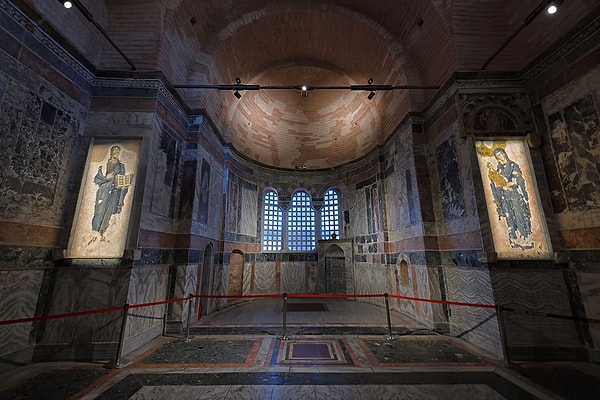
Located in the Edirnekapı neighbourhood, close to the historic land walls, Kariye was originally a church built in the 4th century as part of the Chora Monastery. The present structure was largely reconstructed in the 11th century and adorned with unique mosaics and frescoes added especially in the early 14th century under the patronage of Theodoros Metokhites. It was converted into a mosque during the Ottoman period, and after a long period of restoration, it was reopened for worship as a mosque in May 2024. The mosaics and frescoes are considered among the most important and extensive examples of Late Byzantine art (Paleologos Renaissance).
Prominent Features
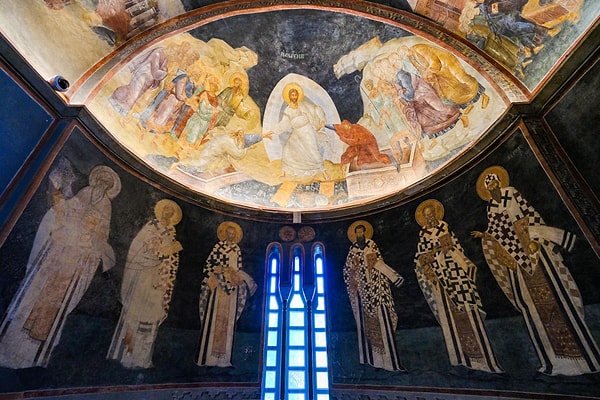
Outer Narthex (Esonarthex) and Inner Narthex (Exonarthex): These sections contain extraordinarily detailed and vivid mosaics depicting scenes from the life of Jesus Christ and the Virgin Mary. The life cycle of the Virgin Mary and the miracles of Jesus are particularly striking.
Parekklesion (Side Chapel): Built as a burial chapel, this section contains frescoes with deep meanings about the Testament and Christian theology, especially the Anastasis fresco. These frescoes display the emotional intensity and expressive power of Byzantine art.
The vividness, mobility and emotional expressions of the figures in the mosaics reflect the artistic innovations of the period.
Visit Tip:
- After visiting the Kariye Mosque in the Fatih district, you can see a part of the historical land walls in the immediate vicinity and take a pleasant walk among the historical wooden houses in the authentic atmosphere of Balat and Fener neighbourhoods. Since it serves as a mosque, visiting hours may be adjusted according to prayer times, so it is worth checking the current situation before you go.
3. Hagia Irene Church

Located in the first courtyard of Topkapi Palace, just behind Hagia Sophia, Hagia Irini is not only one of the oldest churches in Istanbul, but also one of the rare Byzantine churches that was not converted into a mosque after the conquest of the city. First thought to have been built in the 4th century during the reign of Emperor Constantine, it was rebuilt by Emperor Justinian I at around the same time as Hagia Sophia after it burned down during the Nika Uprising in 532. It bears the Roman name 'Hagia Irene', meaning 'Holy Peace', and was the seat of the Patriarchate of Constantinople before the Hagia Sophia. In 381, the Second Ecumenical Council was convened here. During the Ottoman period, it was used as an arsenal (Harbiye Warehouse) and later as a military museum. Today, it serves as an impressive venue for classical music concerts, exhibitions and cultural events.
Architectural Features

It has a typical Byzantine basilica plan with three naves. It differs from Hagia Sophia in that it is covered with a vault instead of a dome in the centre and has an atrium (courtyard).
Its interior is quite simple; the only non-figurative mosaic decoration remaining from the Byzantine period is the large cross in the apse. This simplicity allows the building to reflect the characteristics of early Byzantine architecture.
It is a preferred venue for concerts as its acoustics are quite successful.
Visiting Tip:
- You can visit Hagia Irene by buying a ticket to the Topkapi Palace Museum. It can be an unforgettable experience to get away from the crowds of the palace and take a break in this serene and historical atmosphere, especially if you come across a concert.
4. Fethiye Mosque (Former Pammakaristos Monastery Church)

Located in the Çarşamba neighbourhood of the Fatih district, this building was part of the Pammakaristos Monastery, an important Byzantine monastic church dedicated to the Virgin Mary. Built in the late 13th or early 14th century, it was decorated with rich mosaics, especially during the Palaiologos Dynasty. After the conquest of Constantinople, it housed the Greek Orthodox Patriarchate for a while (1456-1587), and was converted into a mosque in 1591 by Sultan Murad III to commemorate the conquest of Georgia and Azerbaijan under the name Fethiye Mosque. The additional chapel (parekklesion) to the south of the building is now a museum and houses spectacular mosaics from the Byzantine period.
Highlights
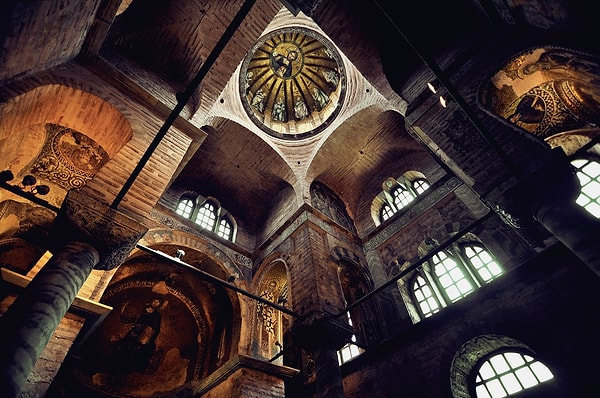
Parekklesion Mosaics: The mosaics in this small chapel, together with those in Kariye, are among the most beautiful examples of Byzantine art of the Palaiologos period. Especially the Pantocrator Jesus, the apostles and various scenes from the Bible are depicted with great skill.
The architecture of the building is typical of the late Byzantine period; the brickwork and complex plan are remarkable.
The period when it served as the Patriarchate marks an important historical period for the Greek Orthodox community in Istanbul.
Visit Tip:
The Çarşamba neighbourhood is a lively and conservative area that preserves its traditional fabric. After visiting the Fethiye Mosque and Museum, you can have a different Istanbul experience by walking through the narrow and historic streets of the neighbourhood. Don't forget to check the visiting hours of the museum section.
5. Sveti Stefan Bulgarian Church (Iron Church)

Located on the shores of the Golden Horn, between the neighbourhoods of Balat and Fener, Sveti Stefan Bulgarian Church is one of the most remarkable buildings in Istanbul with its architectural originality. It is also known as the “Iron Church” because it was built entirely of prefabricated iron. A product of the 19th century efforts of the Bulgarian community in the Ottoman Empire to establish a national church, the church was opened for worship in 1898 after the cast iron and steel parts produced in a factory owned by Rudolph Philipp Waagner in Vienna were brought to Istanbul by ships via the Danube River and the Black Sea and assembled here.
Architectural Features

Reflecting a mixture of Neo-Gothic and Neo-Baroque styles, the church has rich exterior decorations. The entire load-bearing system, walls, facades and even some interior decorations are made of iron.
It was built using approximately 500 tons of iron. This method provided a lighter and more durable solution than a stone structure on the soft ground of the Golden Horn.
The interior features iron columns painted to look like wood, elaborate ornaments, stained glass windows and icons brought from Russia. All six bells in the bell tower were cast in Russia.
Visit Tip:
- Recently undergoing extensive restoration, the church is one of the shining pearls of the Golden Horn. Visiting this unique building in the atmosphere of Balat, full of colourful houses, historic streets and popular cafes, also offers great opportunities for photography enthusiasts. The church is of great importance to the Bulgarian community.
6. Aya Triada Greek Orthodox Church
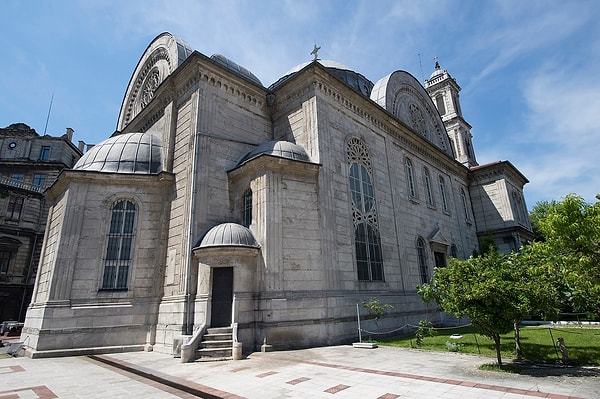
Located at the beginning of Sıraselviler Street, very close to Taksim Square, Aya Triada was built at the end of the 19th century (1880) and is one of the largest and most magnificent Greek Orthodox churches in Istanbul. It was designed by the architect Potessaros and built under the supervision of Vasilaki Ioannidis within the framework of the new rights granted to non-Muslim communities after the Tanzimat Edict.
Architectural Features

The church is characterised by an eclectic combination of Neo-Baroque and Neo-Byzantine styles, with a large dome, two imposing bell towers and an impressive façade.
The interior is adorned with rich frescoes, gold leaf ornaments, marble work and large icons. Especially noteworthy are the dome of Christ Pantocrator and the icon of the Virgin Mary.
It has the appearance of a congregation with its large courtyard and surrounding buildings.
Visit Tip:
- You can take a break in the calm and peaceful courtyard of the church to get away from the crowds and mobility of Istiklal Street for a short time. The church is used extensively during important holidays and rituals of the Greek community.
7. Surp Krikor Lusavoriç Armenian Orthodox Church (Karaköy)

Located on Kemeraltı Street in Karaköy, this church is one of the most important places of worship of the Armenian community in Istanbul. Although the current structure was built in 1901-1902, it is known that there was a much older church (probably before 1431) in the same place. It is therefore considered one of the oldest Armenian churches in Istanbul. It is named after St. Krikor Lusavoriç (St. Krikor the Illuminator), who converted Armenians to Christianity in the 4th century.
Architectural Features
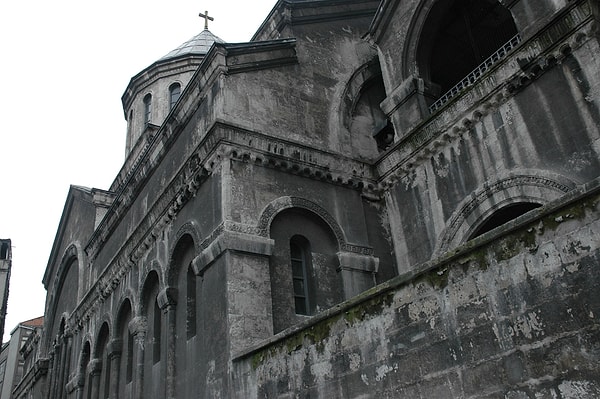
The architects were Nesim and Aram Taalüt Efendi. It has a rectangular plan, a central dome and reflects the characteristics of traditional Armenian church architecture. It was built of cut stone.
The interior has an altar, icons and wood carvings that reflect the beautiful examples of Armenian art. Dark colored wooden pews and simple ornaments attract attention.
The triangular pediment and bell tower at the entrance of the building find a place in the silhouette of Karaköy.
Visit Tip:
- Located on the bustling streets of Karaköy, among modern cafes and art galleries, this historic church reflects the cultural diversity of the neighbourhood. During your visit, you can feel the spiritual heritage of the Armenian community in the tranquil atmosphere of the church.
8. St. Anthony of Padua Catholic Church

Located on Istiklal Street in Beyoglu, St. Antuan Church is the largest and most congregated Catholic church in Istanbul. The current structure was designed by Italian architect Giulio Mongeri in the Venetian Neo-Gothic style and built between 1906 and 1912. However, the history of this church goes back much further, to the first Church of St. Antuan, founded in 1725 by Franciscan friars in Pera. When the original church was demolished, today's magnificent structure was built.
Architectural Features

With its red brick facade, rosette window and monumental entrance, it is one of the most recognisable buildings on Istiklal Street.
The interior is quite impressive, with high ceilings, colourful stained glass windows (especially those depicting scenes from the life of Jesus), statues and mosaic panels. It is in the plan of the Latin cross.
In the courtyard of the church is a statue of Pope Ioannes XXIII (Angelo Roncalli) commemorating his time as Papal Legate in Turkey.
Visit Tip:
- Offering a peaceful sanctuary in the lively atmosphere of Istiklal Street, the church hosts special services on important religious days such as Christmas and Easter. After your visit, you can explore the passages right next to the church or take a pleasant walk towards the Galata Tower. The church hosts services in different languages.
9. Church of Saints Peter and Paulus

Located in the Galata neighbourhood, close to the Galata Tower, this Catholic church was built between 1841 and 1843 by the Swiss-Italian architects Gaspare and Giuseppe Fossati brothers, who were responsible for many important works in Istanbul. The church belongs to the Dominican Order, and the site was previously occupied by an old Dominican church (Church of San Domenico) dating back to the 15th century.
Architectural Features:
It has a basilical plan with Neo-Classical and Neo-Renaissance influences. Although the exterior is simple, the interior is quite ornate.
One of the most striking elements of the interior is the sky-blue dome and the ceiling decorated with gilded stars. Also important are the paintings depicting biblical scenes and the woodwork.
Underneath the church are tombs and crypts from the old chapel.
Visit Tip:
- While exploring Galata Tower and the surrounding area, you can also visit this elegant church. Considering the Fossati brothers' other important work in Istanbul, the restoration of Hagia Sophia, this church is an important example of their architectural approach.
10. Aya Yorgi Patriarchate Church (St. George's Cathedral)
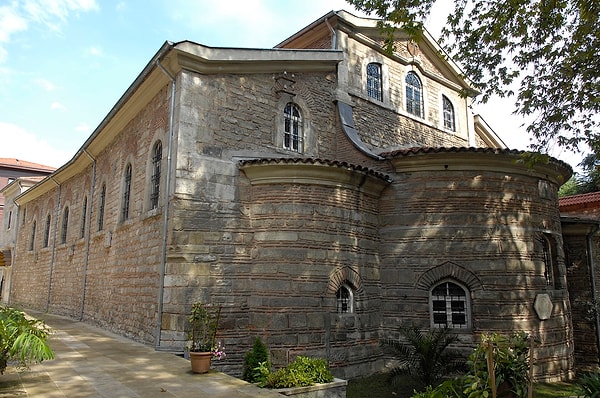
Located in the Fener district, close to the shores of the Golden Horn, Aya Yorgi Church has been the seat of the Fener Greek Orthodox Patriarchate and the main cathedral of the Ecumenical Patriarch since around 1600. It is of great spiritual significance for the approximately 300 million Orthodox Christians around the world. Although humble on the outside, inside it is filled with priceless relics, icons and artistic works.
Highlights

The Patriarchal throne, dated to the 5th century and said to have belonged to Ioannis Chrysostomos (John of the Golden Mouth).
A fragment of the column where Jesus Christ is believed to have been tied and scourged in Jerusalem.
Many valuable icons, especially the mosaic icon of the Virgin Mary (Pammakaristos).
Rich wood-carved iconostasis (icon wall).
Visit Tip:
- Located within the complex of the Greek Patriarchate of Fener, the church is open to visitors, but there may be restrictions on photography. Among the historic streets and colourful houses of Fener, a visit to this important spiritual centre is a unique opportunity to understand the multicultural nature of Istanbul. It is important to respect the visiting hours and rules.
Source: Yollardan.com
Keşfet ile ziyaret ettiğin tüm kategorileri tek akışta gör!

Send Comment